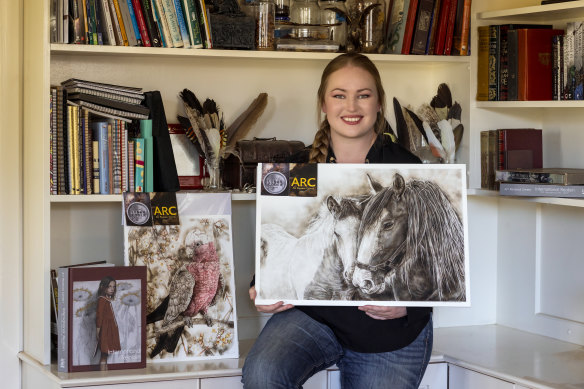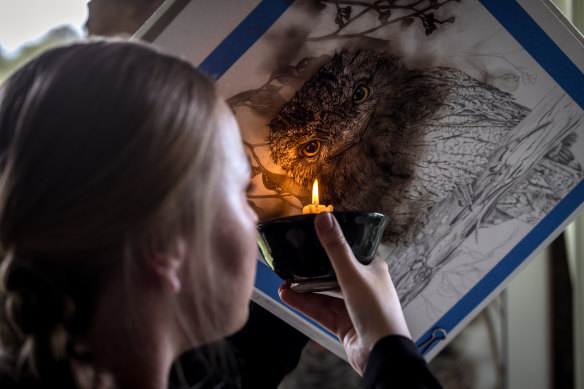
“I’ve peaked,” she says. “This is it. The moon? It’s not going to get better than this.”
But why is this happening?

Three works by Oberhardt are being sent to the moon.Credit: Jason Robins
The Lunar Codex is a passion project run by Samuel Peralta, a semi-retired physicist and author from Canada. He came up with the idea during COVID, when regular exhibitions were not possible, and describes it as “a message in the bottle for the future that during this time of war, pandemic and economic upheaval people still found time to create beauty”.
Billed as “the most expansive and diverse collections of contemporary arts and culture launched to the moon or to space”, the Lunar Codex contains around 250,000 artefacts (including visual art, poetry, literature and more) by more than 40,000 creators from all around the world. It’s the first project to put work by female artists on the moon.
Of course, this isn’t the first time art has been sent to the moon.
Loading
The first was The Moon Museum: a tiny tile covertly attached to Apollo 12 in 1969 by US sculptor Forrest Myers.
It featured small drawings from himself, Claes Oldenburg, David Novros, Robert Rauschenberg, John Chamberlain, and Andy Warhol. The latter offered a literal doodle: a crude drawing of a penis that could charitably be interpreted as either his initials or a rocket.
In 1971, the crew of Apollo 15 placed Paul Van Hoeydonck’s sculpture Fallen Astronaut on the moon – a work later embroiled in controversy over contested accounts about the name and meaning, the artist eventually accused of profiteering off the public space program.
In 1977, NASA launched The Golden Record featuring curated images and sounds from earth including Bach, Beethoven and Chuck Berry’s Johnny B. Goode (Australia’s contribution was Aboriginal music recorded in Arnhem Land).
At the start of this year, Jeff Koons, who creates some one of the world’s most expensive art, celebrated having the first “authorised” artwork on the moon.

Oberhardt at work in her studio.Credit: Jason Robins
Moon Phases is a box with 125 small sculptures of the moon from different vantage points. Each sculpture is inscribed with the name of a notable person, including Leonardo da Vinci and Elvis Presley.
Larger versions of the sculptures are yet to be sold on Earth, with corresponding NFTs which will reportedly show the lunar landing site of the work.
The Lunar Codex is not a commercial project. Creatives can’t buy a place in the collection, nor can they directly nominate themselves.
All featured work has been curated or nominated by a cultural institution. The project doesn’t make money. Peralta foots the bill for the payload (something which is becoming increasingly possible with the rise of space tourism).
“[The Lunar Codex] attempts to instil the moon with some of the heart of humanity, our art, so that when we look at the sky, the moon might become a tangible symbol of hope and of inspiration,” Peralta writes on his website.
Oberhardt doesn’t gaze at the moon. “I’m not really a night owl,” she says.
But the surprising inclusion of her work has given her more confidence in her practice. As a passionate native wildlife advocate, she’s “so happy to get our crazy little pink galahs up on the moon”.
“I just want everyone to see what I see – and appreciate it.”
Find out the next TV, streaming series and movies to add to your must-sees. Get The Watchlist delivered every Thursday.



